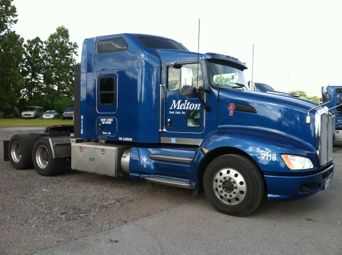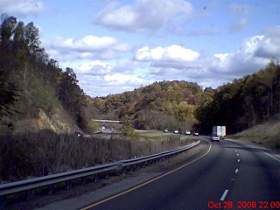The Adventures Of Daniel B.
Topic 1881 | Page 10
Daniel, I've enjoyed following this thread. I kind of feel like Brett though, I haven't really wanted to jump in here with my own clutter. You are doing such a good job of generating questions, and providing great examples of managing your clock while balancing all the concerns of delivery times, down time, and home time that I know others are benefiting from your efforts.
OWI:
Operating While Intoxicated

Daniel, you said that you drained your air tanks. Could you explain why it is important to do that from time to time? Is it to get the water out of the lines or something?
Daniel, you said that you drained your air tanks. Could you explain why it is important to do that from time to time? Is it to get the water out of the lines or something?
Steven, I only have 300 miles left to drive and a few things to do afterwards. Ill give you a good answer as soon as possible. This is a great question and something you need to know. Thank you for asking.
Daniel, you said that you drained your air tanks. Could you explain why it is important to do that from time to time? Is it to get the water out of the lines or something?
Draining your air tanks should be done daily.
You need to find the location of the air tanks and pull the drain valve, you will hear air hiss out of the tank. If you notice water in the tank, keep draining the tank till all of the water is out of the tank. If you truck is equipped with an air dryer and you notice water in the air tanks, you should get it checked out in the shop. Water in the brake system can freeze in cold weather blocking air lines. Your goal is to have dry air going through those air lines.
You could have brake failure with water in your brake system.
When you just turn the drain valve you should see a very small amount of mist coming out. If you drain your air tanks and you notice that there's a lot of water dripping then you need to go to the shop. Your air dryer needs to be looked at by a mechanic. If any colored liquid comes out of the air tanks when you drain them then you need to seriously head to a shop asap.
The location of the air tanks depends on what you're driving. But your primary air tank should be directly underneath your chair as low to the ground. There's usually two tanks for the primary and one for the secondary. The secondary tank is located along your drive shaft before your drive axle.
It's very important to not be lazy about draining them. Moisture builds up and you need to make sure you have as dry air as possible.
Here is the drain valve. Turning this releases the air from the air tank. That nozzle I'm pointing at is the drain valve. As you can see the tank is on the left with a bunch of hoses coming out of it. If you look to the right you'll see my brake chambers. This should give you an idea of where it can be.

SAP:
Substance Abuse Professional
The Substance Abuse Professional (SAP) is a person who evaluates employees who have violated a DOT drug and alcohol program regulation and makes recommendations concerning education, treatment, follow-up testing, and aftercare.
HOS:
Hours Of Service
HOS refers to the logbook hours of service regulations.
Thanks for that, Daniel. At the automotive shop I am currently working at, we have air compressors and there is water in the lines most of the time. We also have an air dryer on the system, but it doesn't work.
I figured that draining the tanks on your truck would have something to do with the water, but I didn't put 2 + 2 together to realize you could have brake failure if the lines froze up because of the water. Good stuff to know. It makes for a good lesson!

Drain compressors weekly

Love reading your posts, Daniel. Mine tend to be rambling compared to yours. I am also amazed at how often you post. Being at shippers and consignees that are sometimes in the boonies, I don't always have a good connection. Not to mention that I am usually dog tired at the end of the day and up WAY to early to take the time.  Keep up the good work. I have acquired a tip or two that I use, based on your posts.
Keep up the good work. I have acquired a tip or two that I use, based on your posts.
Consignee:
The customer the freight is being delivered to. Also referred to as "the receiver". The shipper is the customer that is shipping the goods, the consignee is the customer receiving the goods.
Shipper:
The customer who is shipping the freight. This is where the driver will pick up a load and then deliver it to the receiver or consignee.

This will be a huge help. Thanks for the effort. Keep your notes for a future book. The Life, The Legend, The Trucker, Daniel B...
Larry, I have T-Mobile. They are trash when it comes to having a connection if you're not near a major city. Sometimes I actually write my post in my 'Notes' on my iPhone then I just copy paste. I do what I can to take advantage of the times that I actually do have a good Internet connection. And you're definitely right about being tired at the end of the day. I'm usually exhausted but I force myself to type it real quick. I hate putting things off. Finding time and energy is definitely difficult. Even though I'm using my phone for these posts, I'm not exactly slow at typing. I'm extremely quick on a keyboard though. I can't wait to go home and get my laptop fixed!
Not anywhere near a legend Buda. Haha. Maybe in 24 years! Glad it can help.
New Reply:
New! Check out our help videos for a better understanding of our forum features

















Preview:
This topic has the following tags:
Central Refrigerated Prime Inc Becoming A Truck Driver Dealing With The Boss Driver Responsibilities First Solo Months On The Road Hard Lessons Learned Life On The Road Photos Truck Driving Stories Trucker's Family Matters







 TT On Facebook
TT On Facebook
Daniel,
Have never stopped there, but have been by it many times. Maybe one day I will have/take the time to stop.
You are welcome, not sure what I taught you, but any questions, please ask. I will do my best to answer or direct you to who can answer if I can.
Ernie